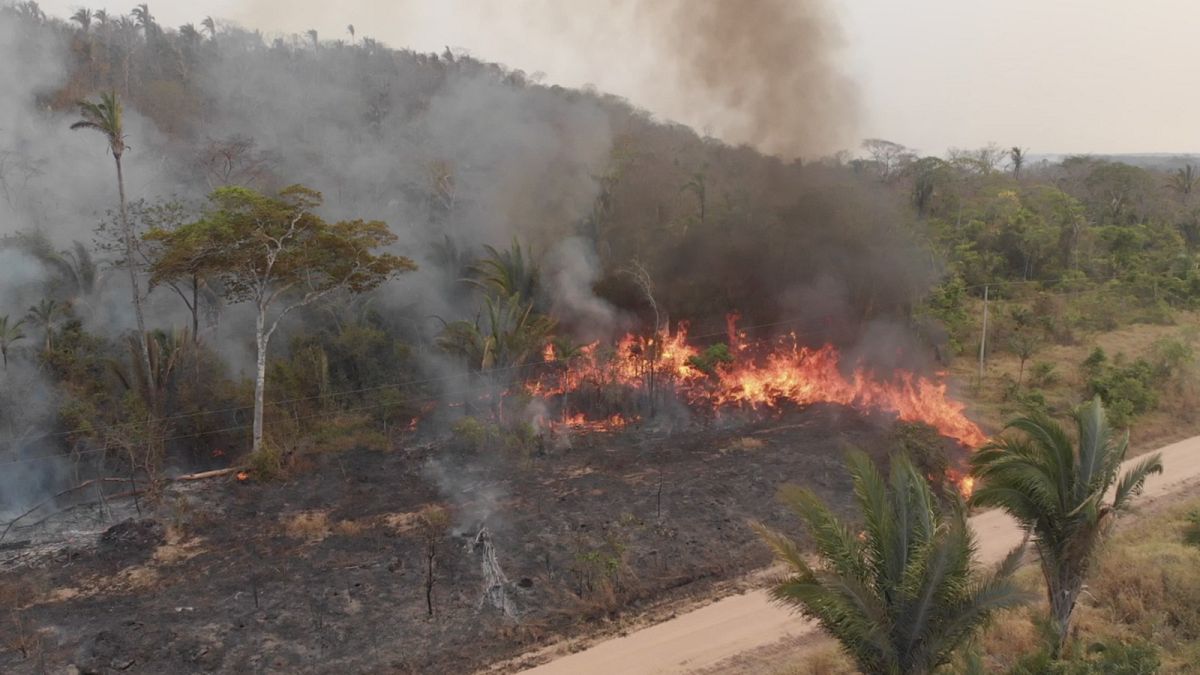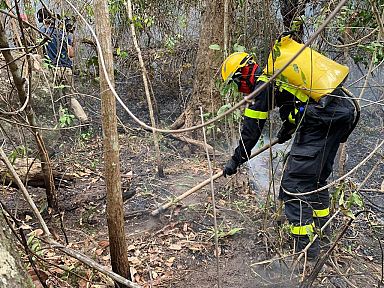The Amazon is on fire, and not only in Brazil. Since July, Bolivia has lost two million hectares of forest, pushing its government to call on the EU to step in.
The Amazon is on fire, and not just in Brazil. Since July, Bolivia has lost 2 million hectares of forest, forcing its government to ask for the activation of the EU Civilian Protection Mechanism. In this month’s Aid Zone, we find out how the EU has provided support in putting out fires in the Bolivian Amazon.
More than 224,000 fires have ravaged the Amazon basin this year and 12 million hectares of forest have been destroyed. In Bolivia, more than 2 million hectares of woodland and savanna have been reduced to ashes in the past two months. The country has deployed more than 5,000 people to fight the flames, including firefighters, troops and volunteers.
Euronews reporter Monica Pinna joined them on the ground:
“Seen from above, the forest surrounding the community of Tierra Hermosa is an endless series of fires. It has been like this since July across the Chiquitanía region, in the department of Santa Cruz, the hardest hit by wildfires. Residents started fighting the flames by themselves, but even with the intervention of the army and volunteers the fires are yet to be stamped out.”
Tierra Hermosa residents such as Reynaldo Rodríguez describe how they tried to fight the fires.
"We have gathered in groups to stop the blaze. We go every evening and every night, but the fires continue to progress. They pass through the branches and because of the sparks, a fire can appear even 30 or 40 kilometres away from another one. We haven’t managed to stop them."
The ancestral practice of chaqueo has been cited as a possible cause
Among the possible causes of the wildfires, experts point to the ancestral practice of chaqueo – slash and burn farming, which in this case has become unmanageable. This year it has intensified, partly as a result of winds and high temperatures. Locals say wildfires are having a huge impact on their livelihoods, which are dependent on farming and cattle breeding.
We followed Eleuterio Álvarez to his patch of land which had been burned the night before. He describes the scene in the Guadalupe community.
"This has all gone. It is like charcoal. This is what we sell in town and what we eat as well. Now I don't know what we are going to do. It's all like this. We've lost it all".
A team of around 40 highly specialised French firefighters arrived in the region in early September, after the Bolivian government called on the EU for assistance. This request triggered the EU Civil Protection Mechanism. We followed the first European team deployed to put out the fires in Tierra Hermosa.
"Our equipment includes a rake allowing us to scratch the ground and separate the fuels and backpack fire pumps. They are filled with 20 litres of water," said Rodolphe Avenel of the French Civil Protection, a humanitarian and first aid voluntary association.
Water is difficult to transport and, as a result, is used very economically. The team walked less than a kilometre into the forest before finding the flames of a long-lasting fire. The blazes here are going backwards against the wind, fueled by dry leaves and branches.
Monica Pinna described the logistical challenges teams faced in moving between the wildfires' areas and their base of operations in San Ignacio.
“It took us eight hours back and forth on a 4x4 along challenging dirt roads. In San Ignacio, the EU based its Emergency Response Coordination Centre. Eight experts from all over Europe have allowed the assistance to be deployed as quickly as possible.”
Euronews spoke to Iván Herreras Hernández, the team leader of the Emergency Response Coordination Centre, operating as part of the EU Civil Protection Mechanism.
"At first we need to co-ordinate aid that member states can send. We help with the deployment of the units and equipment that is sent. We advise local authorities on the best way to use these teams and resources and also suggest how to handle the emergency better."
The EU has supported Bolivia with equipment, teams and information, such as the latest satellite images coming from Copernicus. The EU’s Earth Observation Programme gives Bolivia instant data on the location and development of wildfires, which makes the fight against the flames faster and more efficient.

